Support » Tic Stepper Motor Controller User’s Guide »
1. Overview
The Tic stepper motor controllers are a family of versatile, general-purpose modules designed to control one bipolar stepper motor. With a variety of supported interfaces–USB for direct connection to a computer, TTL serial and I²C for use with a microcontroller, RC hobby servo pulses for use in an RC system, analog voltages for use with a potentiometer or analog joystick, and quadrature encoder for use with a rotary encoder dial–and a wide array of configurable settings, the Tic controllers make it easy to add basic control of a bipolar stepper motor to a variety of projects. A free configuration utility (for Windows, Linux, and macOS) simplifies initial setup of the device and allows for in-system testing and monitoring of the controller via USB.
 |
The Tic T500, shown above, is based on the MP6500 IC from Monolithic Power Systems (MPS). This driver IC supports microstepping with up to 8 microsteps per full step and features automatic decay mode selection, using internal current sensing to automatically adjust the decay mode as necessary to provide the smoothest current waveform. The Tic T500 can operate from 4.5 V to 35 V and features reverse-protection over the full input voltage range. It can deliver up to approximately 1.5 A continuous per phase without a heat sink or forced air flow (the peak current per phase is 2.5 A). The Tic T500’s circuit board is red with white labels.
Powering the Tic T500 with a supply voltage between 4.5 V and 5.5 V might cause its logic voltage to be lower than normal, which could affect its operation. See Section 4.1 for more information.
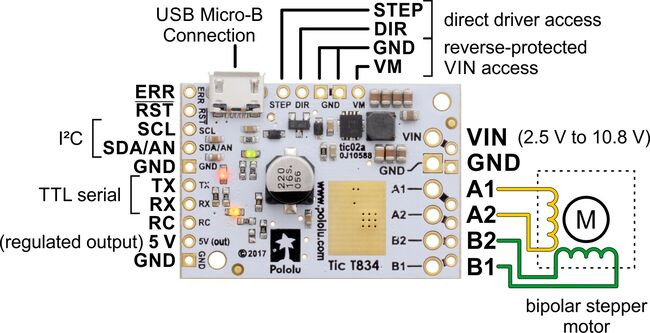 |
The Tic T834, shown above, is based on the DRV8834 IC from Texas Instruments. This driver IC supports microstepping with up to 32 microsteps per full step and features five configurable decay modes. The Tic T834 can operate from 2.5 V to 10.8 V and features reverse-voltage protection over the full input voltage range. It can deliver up to approximately 1.5 A per phase without a heat sink or forced air flow (absolute maximum is 2 A per phase). The Tic T834’s circuit board is white with black labels.
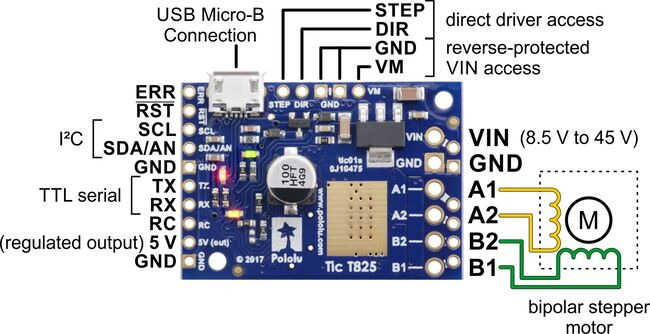 |
The Tic T825, shown above, is based on the DRV8825 IC from Texas Instruments. This driver IC supports microstepping with up to 32 microsteps per full step and features three configurable decay modes. The Tic T825 can operate from 8.5 V to 45 V and features reverse-voltage protection up to 40 V. It can deliver up to approximately 1.5 A per phase without a heat sink or forced air flow (absolute maximum is 2.5 A per phase). The Tic T825’s circuit board is blue with white labels.
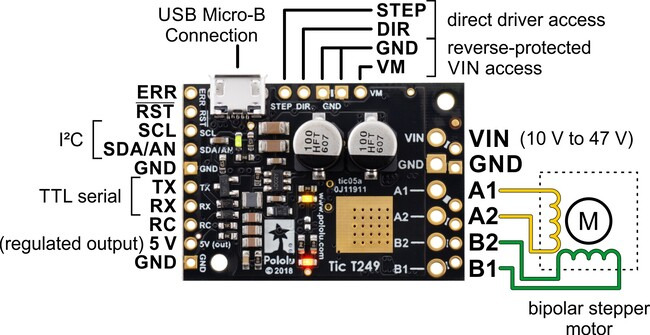 |
The Tic T249, shown above, is based on the TB67S249FTG IC from Toshiba. This driver IC supports microstepping with up to 32 microsteps per full step and offers several unique and innovative features. One of these is Toshiba’s Active Gain Control (AGC), which automatically reduces the stepper motor current below the set limit based on the actual load on the motor, allowing for reduced unnecessary heat generation and higher peak power when the motor actually needs it. Another is Toshiba’s Advanced Dynamic Mixed Decay (ADMD) technology, which dynamically switches between slow and fast decay modes based on the actual motor current, providing higher efficiency and smoother steps at high speed than you get with the traditional timing-based mixed decay. The Tic T249 can operate from 10 V to 47 V and features reverse-voltage protection up to 40 V. It can deliver up to approximately 1.8 A per phase without a heat sink or forced air flow (absolute maximum is 4.5 A per phase). The Tic T249’s circuit board is black with white labels.
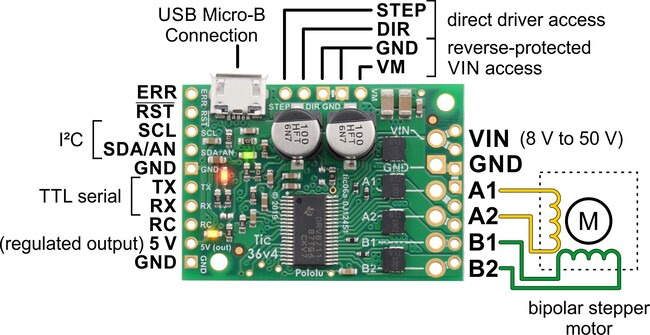 |
The Tic 36v4, shown above, is based on a discrete MOSFET stepper motor driver that supports microstepping with up to 256 microsteps per full step and features six configurable decay modes, including an automatic mixed decay mode. The Tic 36v4 can operate from 8 V to 50 V and features reverse-voltage protection up to 40 V. It can deliver up to approximately 4 A per phase without a heat sink or forced air flow (up to 6 A per phase with sufficient additional cooling). The Tic 36v4’s circuit board is green with white labels.
The table below lists the members of the Tic family and shows the key differences between them.
 Tic T500 |
 Tic T834 |
 Tic T825 |
 Tic T249 |
 Tic 36v4 |
|
|---|---|---|---|---|---|
| Operating voltage range: | 4.5 V to 35 V(1) | 2.5 V to 10.8 V | 8.5 V to 45 V(1) | 10 V to 47 V(1) | 8 V to 50 V(1) |
| Max continuous current per phase (no additional cooling): |
1.5 A | 1.5 A | 1.5 A | 1.8 A | 4 A |
| Peak current per phase (additional cooling required): |
2.5 A | 2 A | 2.5 A | 4.5 A | 6 A |
| Microstep resolutions: | full half 1/4 1/8 |
full half 1/4 1/8 1/16 1/32 |
full half 1/4 1/8 1/16 1/32 |
full half 1/4 1/8 1/16 1/32 |
full half 1/4 1/8 1/16 1/32 1/64 1/128 1/256 |
| Automatic decay selection: |  |
 |
 |
||
| Automatic gain control (AGC): |  |
||||
| Driver IC: | MP6500 | DRV8834 | DRV8825 | TB67S249FTG | discrete MOSFETs |
| Price (connectors not soldered): | $29.95 | $39.95 | $39.95 | $49.95 | $59.95 |
| Price (connectors soldered): | $31.95 | $41.95 | $41.95 | $51.95 | $61.95 |
1 See product pages and user’s guide for operating voltage limitations.
Features and specifications
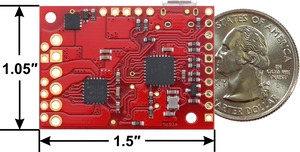 |
Tic T500 USB Multi-Interface Stepper Motor Controller, bottom view with dimensions. This picture shows the original tic03a version that shipped prior to 3 January 2019. |
|---|
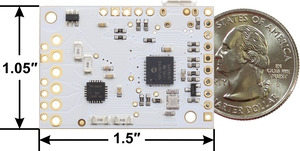 |
Tic T834 USB Multi-Interface Stepper Motor Controller, bottom view with dimensions. |
|---|
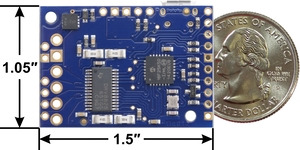 |
Tic T825 USB Multi-Interface Stepper Motor Controller, bottom view with dimensions. |
|---|
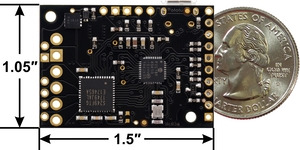 |
Tic T249 USB Multi-Interface Stepper Motor Controller, bottom view with dimensions. |
|---|
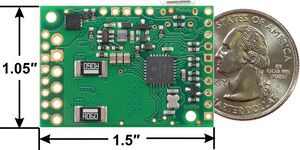 |
Tic 36v4 USB Multi-Interface High-Power Stepper Motor Controller, bottom view with dimensions. |
|---|
- Open-loop speed or position control of one bipolar stepper motor
- A variety of control interfaces:
- USB for direct connection to a computer
- TTL serial operating at 5 V for use with a microcontroller
- I²C for use with a microcontroller
- RC hobby servo pulses for use in an RC system
- Analog voltage for use with a potentiometer or analog joystick
- Quadrature encoder input for use with a rotary encoder dial, allowing full rotation without limits (not for position feedback)
- STEP/DIR inputs for compatibility with existing stepper motor control firmware
- Acceleration and deceleration limiting
- Maximum stepper speed: 50,000 steps per second
- Very slow speeds down to 1 step every 200 seconds (or 1 step every 1428 seconds with reduced resolution).
- Selectable microstep modes up to 1/256-step resolution:
- The Tic 36v4 supports full-step to 1/256-step modes
- The Tic T825, Tic T834, and T249 support full-step to 1/32-step modes
- The Tic T500 supports full-step to 1/8-step modes
- Digitally adjustable current limit
- Decay modes:
- The Tic T500 features automatic decay mode selection.
- The Tic T834 features 5 digitally configurable decay modes.
- The Tic T825 features 3 digitally configurable decay modes.
- The Tic T249 features Toshiba’s Advanced Dynamic Mixed Decay (ADMD) technology.
- The Tic 36v4 features 6 digitally configurable decay modes, including an automatic mixed decay mode.
- Optional safety controls to avoid unexpectedly powering the motor
- Input calibration (learning) and adjustable scaling degree for analog and RC signals
- 5 V regulator (no external logic voltage supply needed)
- Optional limit switch inputs with homing capabilities
- Optional kill switch inputs
- STEP/DIR outputs for controlling external stepper motor drivers
- Connects to a computer through USB via a USB A to Micro-B cable (not included)
- Free configuration software available for Windows, Linux, and macOS












